LEUCORRHEA – YOGA ASANAS
- December 23, 2022
- Posted by Dr. Vaidya Karanvir Singh
- 0 Comment(s)
Table of Contents
INTRODUCTION
Leucorrhea is the whitish discharge from vagina. It is a very common problem in females, especially in present era due to unhealthy lifestyle and eating habits. There are glands which are present in vagina and cervix. They secrete fluid which helps in removing harmful bacteria and dead cells from the reproductive tract. Thus it helps in keeping the reproductive tract healthy. But when there is excessive discharge and changed consistency of the discharge, then it is called leucorrhea.
Normally, the color of vaginal discharge is between transparent to milky white. The amount of discharge differs during phases of a menstrual cycle. It often increases during the sexual arousal, lactation and ovulation. So when the discharge is not normal and there is associated symptoms like burning sensation and itching, then it requires medical attention.
WHAT ARE THE CAUSES OF LEUCORRHEA?
The reasons for the occurrence of vaginal discharge are:
- Not maintaining personal hygiene
- Infection in female reproductive tract
- Sexually transmitted infections
- Pelvic inflammatory disease
- Excessive vaginal douching
- Vaginal sprays
- Use of scented and harsh soaps
- Trichomoniasis
- Diabetes
- During pregnancy
- Stress
- Heavy weight-lifting
WHAT ARE THE SYMPTOMS WHICH ARISE WITH LEUCORRHEA?
Leucorrhea is associated with the following signs and symptoms:
- Vaginal itching
- Swelling of vulva (female external genitalia)
- Burning sensation in vagina
- Fishy odor from vagina
- Yellowish- white discharge
- Thick cheese like discharge from vagina
- Pain during urination
- Pain in pelvis
- Abdominal pain
- Pain during sexual intercourse
- Low grade fever
- Lower backache
- Vaginal swelling
- Constipation
- Indigestion
HOW LEUCORRHEA CAN BE PREVENTED?
Leucorrhea can be easily prevented by following some of the following steps:
- Personal hygiene
- Avoid genital sprays and usage of harsh soaps
- Avoid alcohol intake
- No to consumption of oily and junk foods
- Not indulging in excessive sexual activity
HOW YOGA CAN BE BENEFICIAL IN CURING LEUCORRHEA?
Leucorrhea is the result of an unhealthy lifestyle and bad eating habits. Females are undergoing a lot of stress now-a-days due to their household and office commitments. Yoga asanas can be beneficial in managing stress and leads to normal functioning of the body.
Some of the asanas which are recommended for treatment of leucorrhea are:
1. BHADRASANA
It is also known as Badhkonasana. Badh means restrained, kona means angle and asana means posture. How to do it:
- Sit with spine erect and legs spread straight out.
- Bend the knees and bring the feet towards the pelvis. The soles of the feet should be touching each other.
- Grab the feet tightly with the hands and make the heels as close to genitals as possible.
- Then, press the knees and thighs downwards towards the floor. Now flap both the legs up and down like the wings of a butterfly. One should start slow and then increase the speed gradually. Breathe normally.
- Fly as high as possible and as fast as a person can. Then slow down and stop.
- While breathing out, gently release the posture and straighten the legs in front and relax.
Contraindications:
- Knee injury
- Injury of the groin
- Lower back problem
2. SARVANGASANA
Sarvangasana is also known as shoulder stand. It is a yoga pose in which the whole body is balanced on the shoulders. Sarv means all, anga means a part of body and asana means body posture. It has an influence on the functioning of all the body parts. This asana is known as Queen of the asanas. It is very beneficial for maintaining physical and mental health.
How to do it:
- Lie on the back with hands on the side
- Then, with one movement, lift the legs, buttocks and back so that their weight comes on the shoulders. Support the back with both the hands.
- Keep the legs and spine straight with the help of elbows and hands to the back. The weight should be supported on shoulders and upper arms not on head and neck.
- Breathe deeply while maintaining the posture for 30-60 seconds.
- Then, lower the knees to forehead and bring your hands down to the floor. Without lifting the head, bring the spine down. Lower the legs on the floor and relax for a minimum of 60 seconds.
Contraindications:
- Pregnancy
- Menstruation
- Hypertension
- Glaucoma
- Slip disc
- Neck pain
- Spondylosis
3. DHANURASANA
Dhanu means bow and asana means body posture. In dhanurasana, the shape of the body is made like that of a bow. The pose should be performed 4-5 hour after meals. The best time is of early morning.
How to do it:
- Lie in the stomach with the feet apart.
- Then fold the knees and take your hands backwards and hold the ankles.
- Breathe in and lift the chest up from the ground. Pull the legs upwards and more towards the back.
- Keep the body posture stable and see forward. Pay attention to the breath.
- Maintain posture for 15-20 seconds and bring the legs and chest gently to the ground.
Contraindications:
- Neck injury
- Hernia
- Hypertension or hypotension
- Lower back pain
- Migraine
- Recent abdominal surgery
4. VAJRASANA
Vajra means diamond or thunderbolt and asana means body posture. So vajrasana is thunderbolt pose. It is also known as adamantine pose.
How to do it:
- Sit with the legs stretched straight in front.
- Fold both the legs and sit in a kneeling position. Hips are placed on the heels and toes are pointed behind. Big toes should touch each other.
- Head, neck and spine should be kept in straight line. Place the palms on thighs and face upwards.
- Now exhale and inhale. Beginners can hold the pose for 30 sec whereas experts can hold for a few minutes. After that, straighten your legs.
Contraindications:
- Slipped disc
- Trouble in foot, ankle and knees
5. BHUJANGASANA
Bhujanga means cobra and asana means body posture. Bhujangasana is the cobra or snake pose. It can be done easily at home while lying down on the stomach and then stretching. It gives a good stretch to the body and instantly relieves stress.
How to do it:
- Lie down in stomach with the toes flat and soles facing upwards.
- Rest the forehead on the ground, keep the legs closer with feet and heels touching each other.
- Now slowly lift the body while taking a deep breath in. The navel should be kept in ground level.
- Both the hands should have equal pressure while pulling on and off of the torso from the ground.
- Hold the pose for 4-5 breaths. Then, breathe out and bring the abdomen, chest and head gently on floor.
- Repeat it for 4-5 times.
Contraindications:
- Pregnancy
- Carpal tunnel syndrome
- Hernia
- Recent abdominal surgery
- Fracture of ribs or wrist joints

Dr. Vaidya Karanvir Singh is the younger Vaidya in Chandigarh Ayurved & Panchakarma Centre. He is the fourth generation in his family who is practicing as a general consultant in Ayurved & Panchakarma treatment at Chandigarh. In his practice, he had treated more than 1 Lakh Plus patients worldwide.





